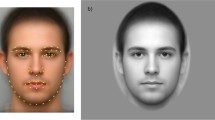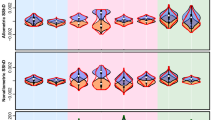Abstract
Several disciplines share an interest in the evolutionary selection pressures that shaped human physical functioning and appearance, psyche, and behavior. The methodologies invoked from the disciplines studying these domains are often based on different rhetorics, and hence may conflict. Progress in one field is thereby hampered from effective transfer to others. Topics at the intersection of anthropometry and psychometry, such as the impact of sexual selection on the hominin face, are a typical example. Since the underlying (evolutionary) theory explicitly places facial form in the middle of a causal chain as the mediating variable between biological causes and psychological effects, a particularly convenient conceptual and analytic scenario arises as follows. Modern morphometrics allows analysis of shape both “backwards” (by regressions on biology) and “forwards” (via predictions of psychology). The two computations are commensurate, hence the two kinds of effects can be compared and evaluated as directions in the same morphospace. We suggest translating the morphometric methodology of “Darwinian aesthetics” into this space, where psychological and other processes of interest can be coded commensurately. Such a translation permits researchers to relate the effects of biological processes on form to the perceptions of the same processes in one unified “psychomorphospace.”
Similar content being viewed by others
References
Bookstein FL (1991) Morphometric Tools for Landmark Data: Geometry and Biology. New York: Cambridge University Press.
Bookstein FL (1996) Biometrics, biomathematics and the morphometric synthesis. Bulletin of Mathematical Biology 58: 313–365.
Bookstein FL, Gunz P, Mitteroecker P, Prossinger H, Schaefer K, Seidler H (2003) Cranial integration in homo: Singular warps analysis of the midsagittal plane in ontogeny and evolution. Journal of Human Evolution 44: 167–187.
Bookstein FL, Schaefer K, Prossinger H, Seidler H, Fieder M, Stringer C, Weber GW, Arsuaga J-L, Slice DE, James Rohlf F, Recheis W, Mariam AJ, Marcus LF (1999) Comparing frontal cranial profiles in archaic and modern homo by morphometric analysis. The Anatomical Record—The New Anatomist 257: 217–224.
Boothroyd LG, Jones BC, Burt DM, DeBruine LM, Perrett DI (2008) Facial correlates of sociosexuality. Evolution and Human Behavior 29: 211–218.
Cornwell RE, Boothroyd L, Burt DM, Feinberg DR, Jones BC, Little AC, Pitman R, Whiten S, Perrett DI (2004) Concordant preferences for opposite-sex signals? Human pheromones and facial characteristics. Proceedings of the Royal Society B: Biological Sciences 271: 635–640.
DeBruine LM, Jones BC, Little AC, Boothroyd LG, Perrett DI, Penton-Voak IS, Cooper PA, Penke L, Feinberg DR, Tiddeman BP (2006) Correlated preferences for facial masculinity and ideal or actual partner’s masculinity. Proceedings of the Royal Society B: Biological Sciences 273: 1355–1360.
Dryden IL, Mardia KV (1993) Multivariate shape analysis. Sankya 55: 460–480.
Dryden IL, Mardia KV (1998) Statistical Shape Analysis. Chichester, UK: Wiley.
Enlow DH, Hans MG (1996) Essentials of Facial Growth. Philadelphia: Saunders.
Feinberg DR, Jones BC, Law Smith MJ, Moore FR, DeBruine LM, Cornwell RE, Hillier SG, Perrett DI (2006) Menstrual cycle, trait estrogen level, and masculinity preferences in the human voice. Hormones and Behavior 49: 215–222.
Fink B, Grammer K, Mitteroecker P, Gunz P, Schaefer K, Bookstein FL, Manning JT (2005) Second to fourth digit ratio and face shape. Proceedings of the Royal Society B 272: 1995–2001.
Folstad I, Karter AJ (1992) Parasites, bright males, and the immunocompetence handicap. American Naturalist 139: 603–622.
Gangestad SW (2000) Human sexual selection, good genes, and special design. Annals of the New York Academy of the Sciences 907: 50–61.
Gangestad SW, Simpson JA (2000) On the evolutionary psychology of human mating: Trade-offs and strategic pluralism. Behavioral and Brain Sciences 23: 573–587.
Good P (2000) Permutation Tests: A Practical Guide to Resampling Methods for Testing Hypotheses. New York: Springer.
Goodall CR (1991) Procrustes methods and the statistical analysis of shape. Journal of the Royal Statistical Society B 53: 285–340.
Gower JC (1975) Generalized Procrustes analysis. Psychometrika 40: 33–51.
Grammer K, Fink B, Møller AP, Thornhill R (2003) Darwinian aesthetics: Sexual selection and the biology of beauty. Biological Reviews of the Cambridge Philosophical Society 78: 385–407.
Gunz P, Bookstein FL, Mitteroecker P, Stadlmayr A, Seidler H, Weber GW (2009) Early modern human diversity suggests subdivided population structure and a complex out-of-Africa scenario. Proceedings of the National Academy of Sciences USA 106: 6094–6098.
Johnston VS, Hagel R, Franklin M, Fink B, Grammer K (2001) Male facial attractiveness: Evidence for hormone-mediated adaptive design. Evolution and Human Behavior 22: 251–267.
Jones BC, DeBruine LM, Perrett DI, Little AC, Feinberg DR, Law Smith MJ (2008) Effects of menstrual cycle phase on face preferences. Archives of Sexual Behavior 37: 78–84.
Kent JT (1994) The complex Bingham distribution and shape analysis. Journal of the Royal Statistical Society B 56: 285–299.
Klein SL (2000) The effects of hormones on sex differences in infection: From genes to behavior. Neuroscience and Biobehavioral Reviews 4: 627–638.
Komori M, Kawamura S, Ishihara S (2009a) Averageness orsymmetry: Which is more important for facial attractiveness? Acta Psychologica 131: 136–140.
Komori M, Kawamura S, Ishihara S (2009b) Effect of averageness and sexual dimorphism on the judgment of facial attractiveness. Vision Research 49: 862–869.
Kraemer S (2000) The fragile male. British Medical Journal 321: 1609–1612.
Little AC, Jones BC, DeBruine LM (2008) Preferences for variation in masculinity in real male faces change across the menstrual cycle: Women prefer more masculine faces when they are more fertile. Personality and Individual Differences 45: 478–482.
Lutchmaya S, Baron-Cohen S, Raggatt P, Knickmeyer R, Manning JT (2004) 2nd to 4th digit ratios, fetal testosterone and estradiol. Early Human Development 77: 23–28.
Manning JT, Scutt D, Wilson J, Lewis-Jones DI (1998) The ratio of 2nd to 4th digit length: A predictor of sperm numbers and concentrations of testosterone, luteinizing hormone and oestrogen. Human Reproduction 13: 3000–3004.
Marcus LF, Corti M, Loy A, Naylor GJP, Slice DE (1996) Advances in Morphometrics. New York: Plenum Press.
Meyer DA, Quong MW (1999) The bio-logic of facial geometry. Nature 397: 661–662.
Mitteroecker P, Gunz P, Bernhard M, Schaefer K, Bookstein FL (2004) Comparison of cranial ontogenetic trajectories among great apes and humans. Journal of Human Evolution 46: 679–698.
Mitteroecker P, Gunz P, Bookstein FL (2005) Heterochrony and geometric morphometrics: A comparison of cranial growth in Pan paniscus versus Pan troglodytes. Evolution and Development 7: 244–258.
Neave N, Laing S, Fink B, Manning JT (2003) Second to fourth digit ratio, testosterone and perceived male dominance. Proceedings of the Royal Society B 270: 2167–2172.
O’Higgins P (2000) The study of morphological variation in the hominid fossil record: Biology, landmarks and geometry. Journal of Anatomy 197: 103–120.
O’Higgins P, Bastir M, Kupczik K (2006) Shaping the human face. International Congress Series 1296: 55–73.
O’Higgins P, Collard M (2002) Sexual dimorphism and facial growth in papionin monkeys. Journal of Zoology 257: 255–272.
O’Higgins P, Jones N (1998) Facial growth in Cercocebus torquatus: An application of three-dimensional geometric morphometric techniques to the study of morphological variation. Journal of Anatomy 193: 251–272.
Penton-Voak IS, Chen JY (2004) High salivary testosterone is linked to masculine male facial appearance in humans. Evolution and Human Behavior 25: 229–241.
Penton-Voak IS, Perrett DI (2000) Female preference for male faces changes cyclically: Further evidence. Evolution and Human Behavior 21: 39–48.
Perrett DI, Lee KJ, Penton-Voak I, Rowland D, Yoshikawa S, Burt DM, Henzi SP, Castles DL, Akamatsu S (1998) Effects of sexual dimorphism on facial attractiveness. Nature 394: 884–887.
Perrett DI, May KA, Yoshikowa S (1994) Facial shape and judgements of female attractiveness. Nature 368: 239–242.
Peters M, Simmons LW, Rhodes G (2009) Preferences across the menstrual cycle for masculinity and symmetry in photographs of male faces and bodies. PLoS ONE 4(1) e4138.
Potter T, Corneille O (2008) Locating attractiveness in the face space: Faces are more attractive when closer to their group prototype. Psychonomic Bulletin and Review 15: 615–622.
Rohlf FJ (1999) Shape statistics: Procrustes superimpositions and tangent spaces. Journal of Classification 16: 197–223.
Rohlf FJ (2000) Statistical power comparisons among alternative morphometric methods. American Journal of Physical Anthropology 111: 463–478.
Rohlf FJ (2003) Bias and error in estimates of mean shape in geometric morphometrics. Journal of Human Evolution 44: 665–683.
Rohlf FJ, Marcus LF (1993) A revolution in morphometrics. Trends in Ecology and Evolution 8: 129–132.
Rohlf FJ, Slice DE (1990) Extensions of the Procrustes method for the optimal superimposition of landmarks. Systematic Zoology 39: 40–59.
Schaefer K, Bookstein FL (in press) Does geometric morphometrics serve the needs of plasticity research? Journal of Biosciences 34(1).
Schaefer K, Fink B, Grammer K, Mitteroecker P, Gunz P, Bookstein FL (2006a) Female appearance: Facial and bodily attractiveness as shape. Psychological Science 48: 187–204.
Schaefer K, Fink B, Mitteroecker P, Neave N, Bookstein FL (2005) Visualizing facial shape regression upon 2nd to 4th digit ratio and testosterone. Collegium Antropologicum 29: 415–419.
Schaefer K, Lauc T, Mitteroecker P, Gunz P, Bookstein FL (2006b) Dental arch asymmetry in an isolated Adriatic community. American Journal of Physical Anthropology 129: 132–142.
Schaefer K, Mitteroecker P, Gunz P, Bernhard M, Bookstein FL (2004) Craniofacial sexual dimorphism patterns and allometry among extant hominids. Annals of Anatomy 186: 471–478.
Scheyd GJ, Garver-Apgar CE, Gangestad SW (2008) Physical attractiveness: Signals of phenotypic quality and beyond. In: Foundations of Evolutionary Psychology (Crawford C, Krebs D, eds), 239–259. Hillsdale, NJ: Erlbaum.
Slice DE (2005) Modern morphometrics. In: Modern Morphometrics in Physical Anthropology (Slice DE, ed), 1–45. New York: Kluwer/Plenum.
Slice DE (2007) Geometric morphometrics. Annual Review of Anthropology 36: 261–281.
Strand Vidarsdottir U, O’Higgins P, Stringer C (2002) A geometric morphometric study of regional differences in the ontogeny of the modern human facial skeleton. Journal of Anatomy 201: 211–229.
Swaddle JP, Reierson GW (2002) Testosterone increases perceived dominance but not attractiveness in human males. Education Economics 269: 2285–2289.
Symons D (1995) Beauty is in the adaptations of the beholder: The evolutionary psychology of human female sexual attractiveness. In: Sexual Nature, Sexual Culture (Abramson PR, Pinkerton SD, eds), 80–120. Chicago: University of Chicago Press.
Thornhill R, Grammer K (1999) The body and face of woman: One ornament that signals quality? Evolution and Human Behavior 20: 105–120.
Thornhill R, Møller AP (1997) Developmental stability, disease and medicine. Biological Reviews of the Cambridge Philosophical Society 72: 497–548.
Tiddeman B, Burt M, Perrett D (2001) Prototyping and transforming facial textures for perception research. IEEE Computer Graphics and Applications 21(5): 42–50.
Weston EM, Friday AE, Johnstone RA, Schrenk F (2004) Wide faces or large canines? The attractive versus the aggressive primate. Proceedings of the Royal Society B 271(S6): 416–419.
Weston EM, Friday AA, Liò P (2007) Biometric evidence that sexual selection has shaped the hominin face. PloS ONE 2(6): e710.
Windhager S, Slice DE, Schaefer K, Oberzaucher E, Thorstensen T, Grammer K (2008) Face to face: The perception of automotive designs. Human Nature 19: 331–346.
Zahavi A, Zahavi A (1997) The Handicap Principle: A Missing Piece of Darwin’s Puzzle. Oxford: Oxford University Press.
Author information
Authors and Affiliations
Corresponding author
Rights and permissions
About this article
Cite this article
Schaefer, K., Mitteroecker, P., Fink, B. et al. Psychomorphospace—From Biology to Perception, and Back: Towards an Integrated Quantification of Facial Form Variation. Biol Theory 4, 98–106 (2009). https://doi.org/10.1162/biot.2009.4.1.98
Received:
Accepted:
Published:
Issue Date:
DOI: https://doi.org/10.1162/biot.2009.4.1.98




